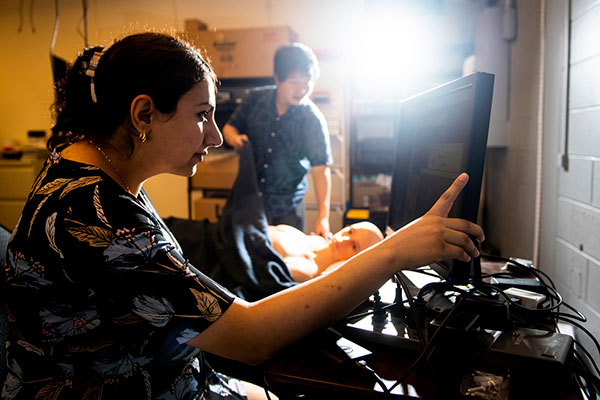Developing New Technology for Social Anxiety Treatment

ECE Associate Professor Sarah Ostadabbas is leading a $500,000 NSF grant, in collaboration with the University of Pittsburgh, for the “Development of a Precision Closed Loop BCI for Socially Fearful Teens with Depression and Anxiety” to introduce a prototype for clinical application of augmented reality (AR)-guided, electroencephalogram (EEG)-based exposure technology for socially fearful teens. The proposed system has the potential to provide a technology-driven paradigm for exposure therapy that meaningfully reflects the social challenges experienced by depressed and anxious teens.
This article originally appeared on Northeastern Global News. It was published by Erin Kayata. Main photo: Sarah Ostadabbas, assistant professor of electrical and computer engineering, and student Shuangjun Liu set up a camera for their sleep study in the Dana Research Center. Photo by Ruby Wallau/Northeastern University
Facing their fears: VR goggles will be used to treat teens with anxiety and depression
Depression and anxiety rates — high even before COVID-19 — have increased over the last few years thanks to the pandemic. The World Health Organization estimates these illnesses affect a quarter of the world’s population and cost the global economy $1 trillion annually. Treatment includes talk therapy, but only so much can be done within the confines of a clinician’s office.
A Northeastern professor is part of the solution to try to change this.
Sarah Ostadabbas, an associate professor in the electrical and computer engineering department, is leading a National Science Foundation grant with the University of Pittsburgh to develop technology that’ll use augmented reality (AR) to help treat teens with anxiety and depression. The proposed system would use hardware — specifically AR goggles — and machine learning software to create an immersive 3D environment to help patients confront their fears in a more realistic way while an EEG cap monitoring their brain activities would allow therapists to track patients’ brain signals, its responses to the fear stimuli, and their progress after a course of prescribed treatment.
“Depression and anxiety have been on the rise dramatically, and unfortunately a lot of these teens do not respond well to the therapy that is prescribed to them,” Osradabbas said. “Teens who don’t respond to standard therapy are at a greater risk of serious consequences, including suicide and shortened life expectancy. Exposure therapy, a well-known treatment, involves gradual real-world exposure to fears. However, asking teenagers to self-monitor fear levels can be challenging. It disrupts their immersion in real-life experiences, reduces authenticity, and might be forgotten, especially during times of heightened social anxiety”
Read full story at Northeastern Global News